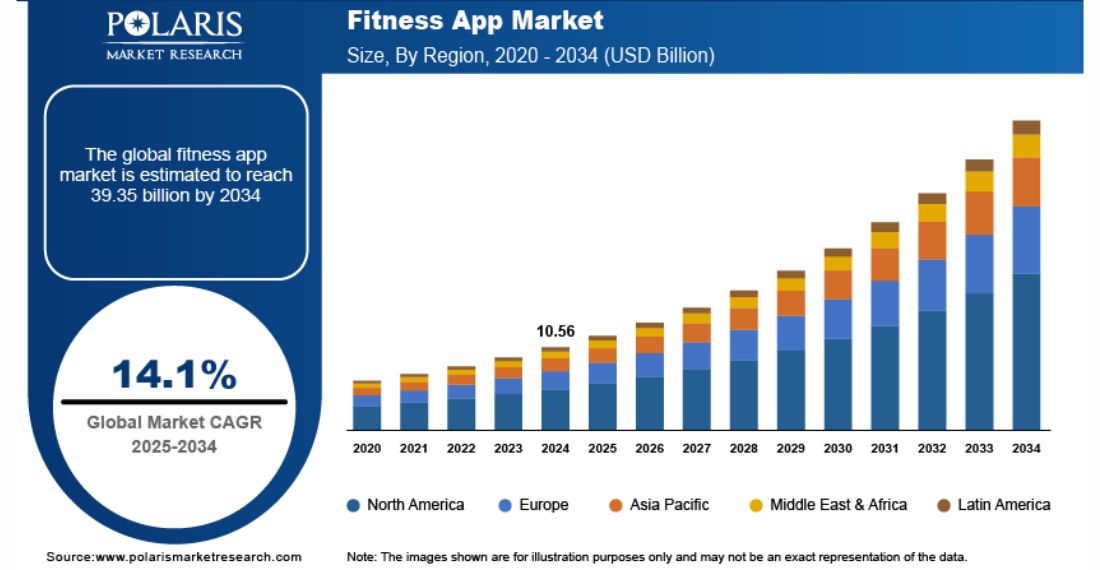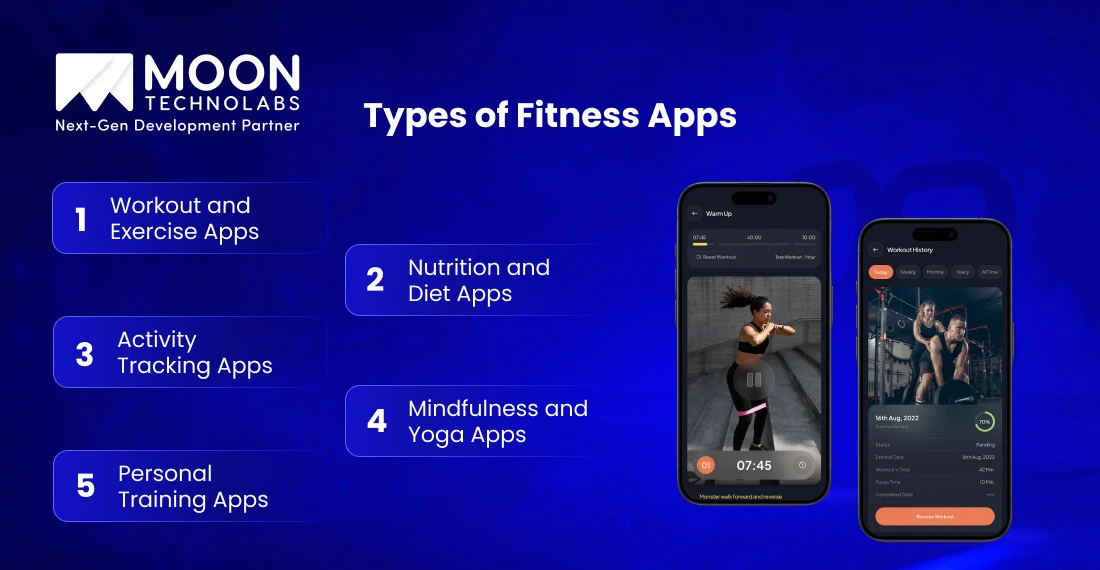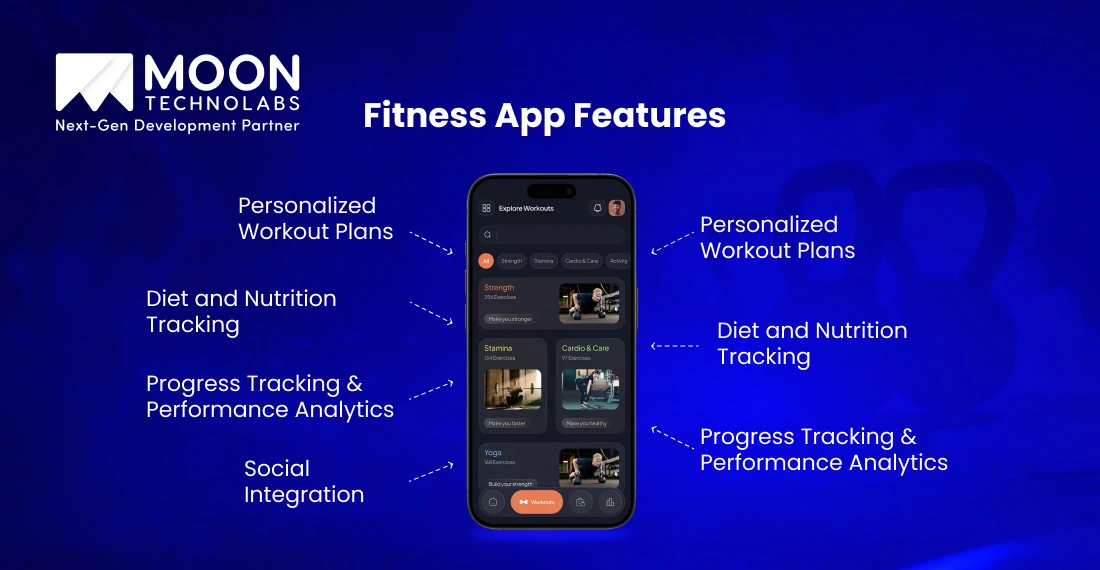Table of Content
Blog Summary:
This blog provides a comprehensive overview of the key factors impacting the cost of developing a fitness app. It examines elements like features, target platforms, backend infrastructure, design, and maintenance that shape the budget and complexity of bringing a fit tech product to market. The blog offers strategic insights to guide entrepreneurs and developers.
Table of Content
Did you know that approximately 26% of users engage with fitness apps at least once a week?
It’s a clear indicator of how integral these app functionalities have become in their daily lives. Hence, developing a fitness app depends on how to keep users engaged and retain them through features of AI recommendations, wearable integrations, and gamification.
The journey of building such an app begins with how businesses can integrate functionalities through a seamless user experience.
However, the real challenge for businesses is figuring out the right fitness app development cost based on the data they gathered, and making informed decisions by considering:
This guide will delve into the crucial aspects of fitness app development cost, offering a comprehensive overview.
Readers will find valuable insights in this blog, setting the stage for a deeper exploration of the dynamic and evolving world of developing fitness apps, which can range from USD 30,000 to USD 1,50,000.
Let’s head to the first section to gain a market overview of the fitness app industry.
The fitness app industry is experiencing a surge, evolving rapidly in response to technological advancements. According to a report by Polaris Market Research, the global fitness app market was valued at USD 10.56 billion in 2024.

It is projected to grow to USD 39.35 billion by 2034, representing a CAGR of 14.1%. Such growth showcases the increasing demand for health and fitness solutions. Central to this expansion is the fitness app business model, which has become increasingly diverse and user-focused.
These models range from subscription-based services to freemium offerings, each catering to different user needs. As technology and user expectations evolve, so too does the landscape of fitness apps.

Exploring the fitness app landscape reveals an array of options, each tailored to different health and wellness goals. From workout trackers to mindfulness guides, the variety is vast.
Here are the main categories that stand out, offering innovative mobile app ideas:
Workout and exercise apps offer personalized training plans and track users’ fitness progress. These apps often feature interactive workouts and performance analytics.
Ideal For:
Expert Tip: Create tailored workouts based on users’ goals, fitness levels, and moods by understanding their behavior and patterns through AI-driven data.
Nutrition and diet apps help users manage their dietary habits by tracking meals, counting calories, and providing valuable insights into nutritional intake.
Ideal For:
Expert Tip: Offer meal recommendations tailored to individual goals, budget, and local cuisine, with features that enable sharing of meal ideas.
Developing a fitness application that helps users track their daily activities is becoming a lucrative business opportunity. Using GPS and sensor data, they offer insights into fitness levels and help in goal setting.
Ideal For:
Expert Tip: Enhance real-time insights and analytics by tracking daily physical activities, such as steps, runs, and cycling, to gain a deeper understanding of your health.
Check out how we recently developed a smart wearable health activity tracking system that monitors heart rate and other vital signs. It provides real-time updates on health and sends instant alerts by monitoring the users’ health 24/7 to detect issues before they become emergencies.
These apps focus on mental well-being, offering guided meditation and yoga routines with a holistic approach to promoting relaxation and stress relief.
Ideal For:
Expert Tip: Offer multiple media formats, such as audio, video, and text, with customizable session lengths and integrate with apps for a seamless experience.
At Moon Technolabs, we have brought this concept to life with our mental health & wellness app, Inner Journey. It seamlessly blends meditation, mindfulness, and self-care features, empowering users to prioritize mental health anytime, anywhere.
Personal training apps connect users with real fitness coaches, offering one-on-one sessions, personalized plans, and feedback.
Ideal For:
Expert Tip: Incorporate video coaching sessions with real-time posture corrections using AI and a review system for users to rate training professionals.

Fitness apps come equipped with a range of features designed to enhance user experience and engagement. Understanding these types is crucial for businesses seeking to develop effective fitness apps.
They significantly influence the development cost of a fitness app, affecting both the strategy and the outcome in this competitive market. Here are some of the key features that can be included in a fitness app:
Personalized workout plans enable users to set goals and track progress, as they are tailored to individual fitness levels, ensuring effective and sustainable progress.
How to Implement:
Tracking diet and nutrition allows users to monitor their dietary habits, offering insights into calorie intake and nutritional balance.
How to Implement:
BONUS: Integrate AI-powered guidance to offer personalized health insights along with a doctor consultation for complete health checkups. Similar to how we did for the DocTalk app.
Activity monitoring and progress tracking enable users to track physical activities, such as steps, runs, and cycling, using sensors for accurate data collection.
How to Implement:
Social integration features allow users to share achievements and challenges with friends, building a sense of community and motivation.
How to Implement:
Integration with wearable devices enables your users to access accurate data on their health activities, thereby enhancing the overall user experience.
How to Implement:
Gamified features enable users to stay engaged with the app and return frequently by leveraging human psychology through rewards and competitions.
How to Implement:
By combining AI and voice recognition, users can get hands-free assistance, guidance on health, and real-time feedback for a personalized experience.
How to Implement:
Cost to develop a fitness app ranges approximately from USD 20,000 to USD 1,50,000. The complexity of core features, in terms of basic, medium, and advanced versions, determines the budget implications.
Below, we have compared the features that you can build in your custom app for all three versions. We have also compared the top apps ruling the market in these features:
| Feature Type | Est. Basic App Costs (USD) | Est. Medium App Costs (USD) | Est. Advanced App Costs (USD) | Top Similar Apps |
|---|---|---|---|---|
| GPS activity | 2000 – 4000 | 6,000 – 10,000 | 12,000 – 25,000 | MapMyRun, Strava, Nike Run Club |
| Workout Plans | 4,000 – 6,000 | 8,000 – 15,000 | 18,000 – 30,000 | Pumatrac, Freeletics |
| AI Recommendations | 8,000 – 10,000 | 12,000 – $20,000 | 25,000 – 40,000 | Strava and Pumatrac |
| Social features | 4,000 – 6,000 | 7,000 – 12,000 | 15,000 – 20,000 | Strava, Runkeeper |
| Gamification | 5,000 – 10,000 | 12,000 – 15,000 | 20,000 – 40,000 | Zwift, Freeletics |
| Nutrition and calories tracker | 4,000 – 8,000 | 10,000 – 18,000 | 20,000 – 30,000 | MyFitnessPal, Lifesum |
| Voice Assistance | 5,000 – 8,000 | 8,000 – 14,000 | 15,000 – 25,000 | Pumatrac, Future |
| Interactive Workouts | 6,000 – 10,000 | 15,000 – 25,000 | 30,000 – 60,000 | Relive, Zwift |
| Wearable Integration | 5,000 – 8,000 | 10,000 – 20,000 | 25,000 – 55,000 | Garmin Connect, MapMyRun |
| Live Streaming | 3,000 – 5,000 | 12,000 – 18,000 | 20,000 – 65,000 | Zwift, Future |
| Analytics | 4,000 – 8,000 | 10,000 – 15,000 | 20,000 – 40,000 | Nike Run Club |
| Maintenance Updates | 5,000 – 10,000 (per year) | 15% of total development costs | 20% of total development costs | – |
Leverage expert insights to estimate your fitness app development cost and align it with your business goals.
Monetizing your fitness apps ensures a steady revenue stream. However, the type of strategies you blend highly depends on the user preferences and patterns. The average revenue per user (ARPU) of a fitness app is approximately USD 20.79, indicating that users are willing to pay for premium features and subscriptions.
Here are some strategies that you can implement with their pros and cons:
This model offers basic features at no additional cost, but premium features are also available for an extra fee. It’s an excellent model for attracting a huge user base by offering free features and then upselling with premium ones.
| Pros and Cons |
|---|
|
This model charges users a recurring fee to access all the app’s features through monthly and yearly subscriptions for tiered plans tailored to different user needs.
| Pros and Cons |
|---|
|
This model allows users to purchase specific add-ons within the app, including features, content, and virtual goods. It offers flexibility to choose what users need.
| Pros and Cons |
|---|
|
This model enables revenue generation by incorporating ads with proper placements without charging users and earning commissions.
| Pros and Cons |
|---|
|
The cost of developing a fitness app can vary greatly based on several key factors. These elements range from design complexity to the technology used.
Here are the main considerations impacting the fitness app development cost:
The complexity and range of features, from basic step tracking to advanced AR workouts, directly impact the cost of developing a fitness app. Developers must strike a balance between innovation and budget considerations to create a successful app.
Here’s a tabular breakdown of what it includes:
| Feature Type | Complexity | Impact on Costs |
|---|---|---|
| Basic functionalities like step counters or workout logs | Simple and cost-effective | USD 5,000 – USD 10,000 |
| Advanced features, such as personalized workout plans generated by AI | High complexity and cost | USD 20,000 – USD 40,000 |
| Machine learning to customize fitness routines for each user based on their progress and feedback. | High – algorithms require more time and specialized skills. | USD 15,000 – USD 30,000 |
| Real-time health monitoring features that track heart rate and provide feedback during workouts | High – involves integrating complex sensor data and interpreting it accurately, which is more resource-intensive. | USD 10,000 – USD 25,000 |
| Social features like sharing fitness achievements or competing with friends, | Moderate – require additional programming to ensure smooth social interaction within the app. | USD 15,000 – USD 40,000 |
| Incorporating immersive technologies like augmented reality (AR) for interactive workouts | Very High – Developing an AR feature that demonstrates exercises in a 3D space requires advanced programming and graphic design skills. | USD 40,000 – USD 80,000 |
| Regular updates and ongoing maintenance post-launch | High – Frequent updates with new workouts or challenges will incur higher long-term costs than a more static app. | USD 10,000 – USD 20,000 per year |
The backend infrastructure of a fitness app is pivotal in ensuring its smooth operation and scalability. It encompasses various elements, including servers, databases, and cloud services.
The choice of server, whether it’s a dedicated server, a shared server, or a cloud-based solution, has a significant impact on development costs. Here are the factors that affect the backend infrastructure’s cost:
The choice between a native app and a cross-platform application affects the cost. Native apps provide a better user experience and performance, but are more expensive to develop compared to web apps or hybrid solutions:
When one develops a fitness mobile app, the target audience’s preferences should guide the design process. A fitness app for serious athletes might have a different design approach compared to one targeting casual users.
Hence, the design’s complexity, platform-specific adaptations, and ongoing improvements significantly contribute to the development cost and the app’s success.
Incorporating third-party integrations into a fitness app can greatly enhance its functionality with social media sharing, payment gateways, or health data syncing. Each integration requires time and resources to implement and test, ensuring seamless operation within the app.
However, they also significantly impact the development cost and complexity:
Post-launch maintenance and support are critical components encompassing a range of activities essential for the app’s longevity and user satisfaction. The cost of maintenance can vary, but typically ranges from 15% to 20% of the initial development cost per year, including server costs, hosting fees, and ongoing support services:
Engaging with a mobile app development company for ongoing maintenance ensures the app remains up-to-date and operates efficiently.
Variations in economic conditions, labor costs, and the level of expertise available in different regions significantly impact the costs. Hence, it’s essential to consider the expertise of the fitness app development company in specific types of fitness apps.
A company specializing in gamified fitness apps might charge more due to its niche expertise compared to a company with a broader focus.
Development costs in North America can range from $100 to $250 per hour. In contrast, Eastern Europe, with countries like Ukraine and Poland, offers a balance of cost and quality. Development costs here range from $40 to $100 per hour.
Asia, particularly India and Southeast Asia, is known for offering the most cost-effective solutions. Known for being the most cost-effective, the hourly rates in these regions can range from $20 to $50 per hour.
However, time zone differences and potential communication barriers are important considerations when outsourcing to these areas.
There are several hiring models, each with its own set of pros and cons, which can impact the overall budget and project execution. They significantly shape the budget and scope of the fit tech project. Based on this, the cost of developing a fitness app can range from $25,000 to $150,000.
The most common hiring models include in-house development teams, freelancing developers, and outsourcing to development companies.
While agile methodologies can accelerate development and improve quality, they require skilled project managers and may sometimes lead to scope creep, which can impact overall project costs.
The choice between a fixed-price contract and a time-and-materials contract also affects the budget. Fixed-price contracts offer a clear budget but can be rigid and may not easily accommodate changes. Time-and-materials contracts offer flexibility but can lead to higher costs if not managed carefully.
There are several strategies to reduce the cost of developing a fitness app. These include starting with a minimum viable product (MVP), selecting the right technology stack, outsourcing, efficient project management, focusing on scalable architecture, and striking a balance between in-house and outsourced work.
Let’s understand them in detail:
By launching with just the essential features, one can test the market response and gradually build upon the app based on user feedback. This approach not only saves initial costs but also facilitates data-driven improvements.
Opting for cross-platform development tools like React Native or Flutter can reduce costs, as they allow for a single codebase to be used across both iOS and Android platforms. This eliminates the need to develop separate apps for each platform, saving time and resources.
Outsourcing in a region with lower development costs can also be a viable option. Countries like India and Ukraine, among others, offer competitive rates without compromising the quality of work.
Robust project management can ensure cost savings and manage the development process more effectively, reducing the time and resources spent on each phase. Regular reviews and iterations can prevent costly rework at later stages.
Building an app with scalability in mind ensures that the incremental cost of adding new users or features is minimal. This approach not only saves costs in the long run but also makes the app more adaptable to future growth.
Moon Technolabs delivers transparent cost estimates to fit your budget and goals.
Is your business ready to make its mark in the competitive fitness app market, but unsure if the cost will fit under your budget?
We can translate your ideas into a feature-rich, scalable, and user-centric product that stands out in a crowded market. Our team understands the nuances of fitness app development costs, ensuring our clients receive the best value for their investment.
At Moon Technolabs, we relentlessly focus on quality, transparent pricing, and our commitment to guiding clients through each step of the development process. With Moon Technolabs, you are partnering with a team dedicated to bringing their fit tech vision to life.
Build a fitness app that gets results. Book a FREE call TODAY.
01
02
03
04
05
Submitting the form below will ensure a prompt response from us.